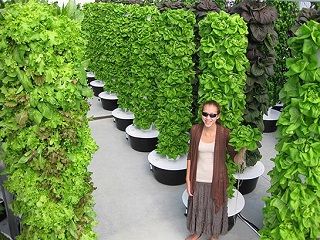More on Aeroponics–A Key Player in Sustainable Agriculture

Upscale restaurants and organic grocers for foodies are one thing. But to analyze where this must eventually end up, and try to find a path from the rooftops of high-end restaurants to large-scale operations that could feed a modest percentage of the human species… There are chasms to cross….It will eventually happen because it must, and once all options start running dry someone is going to throw the Hail Mary. Until then, this is just a high-end and novel form of gardening.
Before I begin, I forgot to mention how fantastically well this works, given that a) dirt, even though it’s all we have, really isn’t an excellent growing medium in most cases, and b) plants use two extremely tiny slices of the electromagnetic spectrum from the sun; most of it’s wasted, which is why LED lights are such a surprisingly cost-effective and efficient replacement for natural sunshine. The photo here depicts how dense and how lush aeroponic operations can be.
Re: your comments on business trajectory, I hear you. I presume your use of the term “chasm” is a reference to 1990s business author Geoffrey Moore and his best-seller “Crossing the Chasm,” which was all the rage at the time. I spent a great deal of my career as a marketing consultant working for clients from the Fortune 100 who had interpreted that book one way or another and were busily trying to tell me how I needed to do my work for them accordingly. Having said that, Moore made some extremely important points, one of which you bring up here, regarding what is generally referred to as the “valley of death” that can be experienced by “disruptive technology.”
Yes, all these variations on the theme of aeroponics are disruptive in the extreme, but here’s what I predict:
Individual tower gardens can be used by a wide group of people who would love to grow their own vegetables (or marijuana – in legal states, one hopes), but don’t want to deal with the time and expense invested in soil prep, the sweat involved in weeding, the frustration of pests, etc. of conventional gardening.
Larger systems can be deployed by:
• Military bases
• Corporate campuses
• Places around the globe where water is scarce
• Places where the growing season is short, i.e., where sunlight is scarce
• Inner city communities where nutritious food is scarce
• Grocery store chains that want to sell all-organic, locally grown food. Keep in mind that 45% of respondents to a recent Gallup poll say that they actively seek out organic fruits and vegetables. That’s a much larger swath of the populace than those who are commonly called “foodies.”
Now, of course, there is a limit here; you won’t find fruit trees growing out of these things.
At the end of the day, however, I think there is a huge market, and a fairly smooth growth trajectory from there.
Of course, certain macro factors also weigh heavily in all this, e.g., public sensibilities, international trade agreements and tariffs, and the price of transportation fuel. When we think of fuel, we naturally think diesel for trucks, but increasingly, our food is moved around with jet fuel consumed in flying produce up from South America.
All in all, there is a handsome array of market forces causing the expansion of aeroponics, but as far as I can see, it’s impossible to predict which of these ingredients will ultimately prove to be most important.
